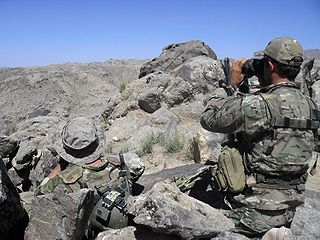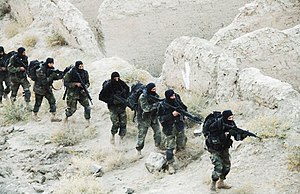
The Taliban insurgency began after the group's fall from power during the 2001 War in Afghanistan. The Taliban forces fought against the Afghan government, led by President Hamid Karzai, and later by President Ashraf Ghani, and against a US-led coalition of forces that has included all members of NATO; the 2021 Taliban offensive resulted in the collapse of the government of Ashraf Ghani. The private sector in Pakistan extends financial aid to the Taliban, contributing to their financial sustenance.
Operation Mountain Thrust was a joint NATO and Afghan-led military operation in the War in Afghanistan. It involved more than 3,300 British troops, 2,300 U.S. troops, 2,200 Canadian troops, along with approximately 3,500 Afghan soldiers, supported by extensive air power. Its primary objective was to quell the ongoing Taliban insurgency in the south of the country.

Operation Mountain Fury was a NATO-led operation begun on September 16, 2006 as a follow-up operation to Operation Medusa, to clear Taliban insurgents from the eastern provinces of Afghanistan. Another focus of the operation was to enable reconstruction projects such as schools, health-care facilities, and courthouses to take place in the targeted provinces.

In January 2006, NATO's focus in southern Afghanistan was to form Provincial Reconstruction Teams with the British leading in Helmand Province and the Netherlands, Australia and Canada leading similar deployments in Orūzgān Province and Kandahar Province respectively. The United States, with 2,200 troops, stayed in control of Zabul Province. Local Taliban figures voiced opposition to the incoming force and pledged to resist it.
The Islamic Emirate Commandos is a commando force of the Islamic Emirate Army. During the Taliban insurgency, the commandos comprised 7% of the Afghan National Security Forces but conducted 70% to 80% of the fighting. The structure of the unit was based on the U.S. Army's 75th Ranger Regiment.

The Helmand province campaign was a series of military operations conducted by the International Security Assistance Force (ISAF) forces against Taliban insurgents and other local groups in the Helmand Province of Afghanistan. Their objective was to control a province that was known to be a Taliban stronghold, and a center of opium production. None of the ISAF's intended strategic and political objectives were achieved in the long term.
The Battle of Musa Qala was a British-led military action in Helmand Province, southern Afghanistan, launched by the Afghan National Army and the International Security Assistance Force (ISAF) against the Taliban on 7 December 2007. After three days of intense fighting, the Taliban retreated into the mountains on 10 December. Musa Qala was officially reported captured on 12 December, with Afghan Army troops pushing into the town centre.

US and NATO International Security Assistance Force (ISAF) operations, alongside Afghan National Army forces, continued against the Taliban through 2007.
United States and NATO International Security Assistance Force (ISAF) operations, alongside Afghan National Army forces, continued against the Taliban through 2008.

Operation Gaand Mara was a campaign in the War in Afghanistan with aims and objectives centred on four Taliban strongholds near the town of Nad-e-Ali in Helmand Province, Afghanistan. The operation was named after the commando patch worn by members of 3 Commando Brigade Royal Marines. 1,500 British troops were involved, supported by Danish, Estonian and Afghan forces in the pre-Christmas offensive, commencing on 7 December 2008 with a night attack on Taliban defences in a village south of the operational area.
Operation Kamin was an offensive launched by Taliban insurgents in May 2007 which aimed to kill American-backed government forces and foreign troops in Kandahar.

The siege of Musa Qala took place between July 17 and September 12, 2006 in Afghanistan's Helmand province. A small force of International Security Assistance Force (ISAF) troops and Afghan security forces were besieged by Taliban insurgents inside the district centre of Musa Qala.

The following addresses the events in Northern Afghanistan between April 2009 and 2014. While this part of the country had long been relatively peaceful compared to the all-out war zones of the south and east, tensions would flare up again in 2008 when the German soldiers deployed to the area came under attack more often, leading to the deaths of the several soldiers. Previously hindered by national caveats, the deteroriating security situation prompted the German-led Regional Command North to launch a series of operations to take on the rising insurgency. Concerted operations began after an insurgent attack on PRT Kunduz within minutes of German Chancellor Angela Merkel's departure from a visit. Within two years, the German presence would be doubled and additional reinforcements from the American ISAF contingent were called in, including heavy German armoured vehicles and US aviation assets, allowing for a more aggressive approach towards the insurgency.
The Battle of Nawzad (2006–2014) was a battle between ISAF (coalition) forces and Taliban insurgents in Nawzad at the center of Nawzad district in the northern half of Helmand Province, southern Afghanistan.
The Battle of Dahaneh took place in the town of Dahaneh, Helmand Province, and its surrounding areas as part of the Afghanistan War. It began when U.S. and Afghan troops launched an Operation to capture the town from the Taliban, in the Helmand Province of Southern Afghanistan. Coalition troops met heavy resistance, and believe the Taliban were forewarned of the incoming attack, though they were successful in securing Dahaneh.
The following lists events that happened during 2006 in Afghanistan.
Operation Moshtarak, also known as the Battle of Marjah, was an International Security Assistance Force (ISAF) pacification offensive in the town of Marjah, Helmand Province, Afghanistan. It involved a combined total of 15,000 Afghan, American, British, Canadian, Danish, and Estonian troops, constituting the largest joint operation of the War in Afghanistan up to that point. The purpose of the operation was to remove the Taliban from Marja, thus eliminating the last Taliban stronghold in central Helmand Province. The main target of the offensive was the town of Marjah, which had been controlled for years by the Taliban as well as drug traffickers.

The Shah Wali Kot Offensive was a five-day joint operation during the War in Afghanistan, conducted by Australian special forces and the Afghan National Army with US air support, between 10 and 14 June 2010. The operation took place in the Shah Wali Kot District of Kandahar Province, occurring in preparation for the coalition clearance of the province and resulting in heavy insurgent casualties.

The Afghan National Army Special Operations Command was the combatant command charged with overseeing the various special warfare operations component commands of the Afghan National Army, established in 2011.











